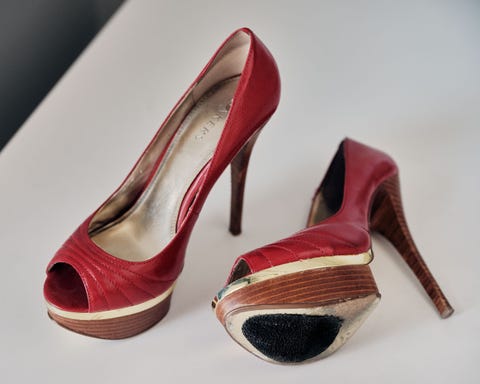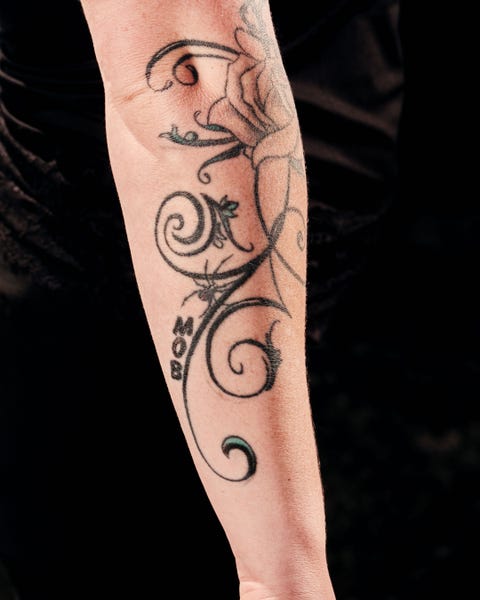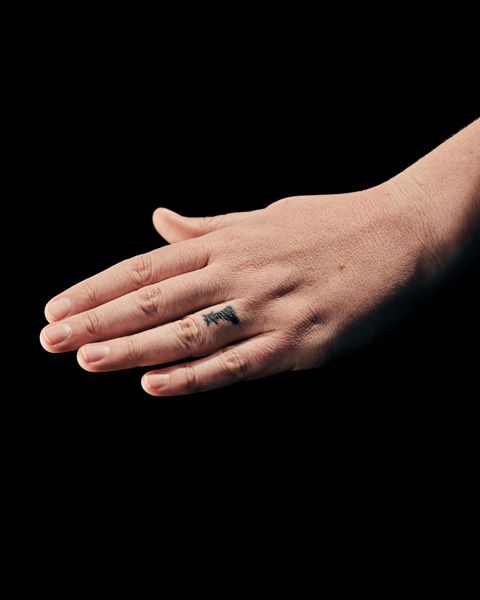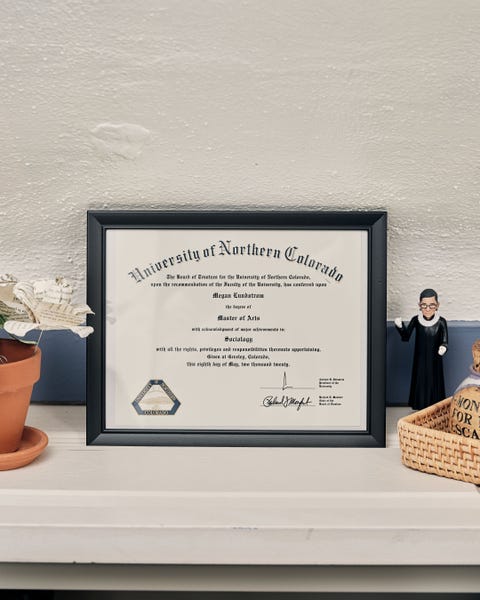The Unlikely Story of a Sex Trafficking Survivor and the Instagram Account That Saved Her Life
There are three types of pimps. Megan Lundstrom will tell you this. First, there’s the boyfriend pimp, the one who romances you with promises of a family, who coaxes you into turning tricks each night to finance a blissful future—the one you think you’re in love with, until the abuse becomes too much to bear. If you try to escape, the boyfriend pimp flips out.
Then there’s the CEO pimp. He’s flirty at first, but instead of wooing you, he works you to exhaustion with promises of modeling fame. He charges a “choosing fee” to enter his enterprise and a “leaving fee” to exit. He, too, gives you bruises, but this is business, and you’ve got a quota. You go on autopilot, which numbs the pain.
Finally, there’s the gorilla pimp. You might meet him at a bar and wake up later having been drugged, kidnapped, and raped.
Lundstrom will also tell you that she’s experienced two of the three pimps. But that’s just the beginning of her story. The 36-year-old Coloradan gained most of her knowledge about the so-called life after her escape, having traveled an unlikely path from sex work to sociology. Throughout her journey, she carried a secret—something that would send her career soaring.
The study of active commercial sex exploitation is relatively recent, with scholars often relying on secondary sources like court documents and police reports, which hardly scratch the surface. But such methods are of little use to Lundstrom, who lays claim to an underground gold mine of primary source material: a private Instagram account followed exclusively by active prostitutes and trafficking survivors.
Created a decade ago as her only means of socialization, the account at one point was co-opted by her pimp as a recruiting tool. But since Lundstrom’s escape, her following has surged from around 50 to more than 2,200 women, providing a database now used to unlock the mysteries of a brutal but hidden crime and expand the bounds of social science. This past year has been the most revelatory yet. COVID-19 has shaken up all kinds of professions—including, it seems, the world’s oldest—pulling many young women into a dangerous line of work in order to make ends meet.
Lundstrom was born in Greeley, Colorado, a university town of about 100,000 that was founded in 1870 as an experimental utopian community but is now mostly known for its smelly meatpacking plants. Her childhood was sheltered, with fresh-baked cookies awaiting her return from soccer practice or orchestra rehearsal. She made the honor roll and earned a college scholarship.
Plans changed when, at 18, she got pregnant by her boyfriend, a Kmart coworker. Lundstrom envisioned a domestic life, not uncommon for Greeley girls. But after a second child, their marriage fell apart, she says. At 23, she left her husband and moved to Denver with her kids to start a new life.
She found work as a teacher’s assistant, but Lundstrom struggled to pay her rent and bills. That’s when a friend told her about a website called SeekingArrangement. “She was like, ‘Think about it—you don’t want a committed long-term relationship, you just go on dates with rich men to nice restaurants,’ ” Lundstrom recalls. “It seemed super casual.”
The concept, known as “sugaring,” has been around since the early 1900s, when San Francisco socialite Alma de Bretteville coined the term “sugar daddy” in reference to her much older sugar-magnate husband, Adolph Spreckels—and has only grown in the age of online dating. Sites like SeekingArrangement (which Rep. Matt Gaetz allegedly used) often pair wealthy men with cash-strapped “sugar babies.” Money or gifts are often exchanged for going on dates. While Lundstrom didn’t realize it initially, sex is often a tacit part of sugar-dating. If that sounds like prostitution…well, based on her experiences, Lundstrom would argue it is.
As opposed to escorting, with inherent expectations, sugaring sites market themselves as progressive, win-win dating brokerages. But it’s all a sham, says Benjamin Gauen, a prosecutor for King County in Seattle who exclusively works on commercial sexual exploitation and human trafficking cases. “Sugar websites are the new frontier of exploitation because they blur the criminality of transaction,” he says. The victims in his professional orbit are minors; buyers are affluent and privileged.
SeekingArrangement founder and CEO Brandon Wade denies his site is a prostitution platform, suggesting that perhaps 5 percent of members “use it wrongly.” He works with the FBI, he says, and removes rogue users on a daily basis. “You want to hire a prostitute, there’s a much faster way to do that than play this dancing game,” he says. A “beginner’s guide” blog post on the site states “Sugar dating is just like any other dating. Sex should be aspired to, but never required.” And to be sure, not every sugar baby reports a negative experience. Some claim financial empowerment, while others question the difference between having sex with a stranger from a nightclub and a stranger met online.
After Lundstrom created her SeekingArrangement profile, she watched her inbox flood with messages, many about sex. The first guy rolled up in a luxury car with a giant long-haired dog in tow. Back at his open-concept loft in downtown Denver, he instructed Lundstrom to position herself on a particular side of the bed, then kept ducking out of sight, as if to adjust a hidden camera. The dog followed him everywhere. Lundstrom couldn’t go through with sex that night, though she did have intercourse with the next guy, who slapped her during the act and didn’t pay afterward. The third guy smoked lots of weed, listened to jam bands, and told her he’d post a favorable review on a local sex forum. That’s when Lundstrom realized she wasn’t a sugar baby. She was a prostitute.
One afternoon as she pumped gas, a man rolled up in a nice car and showered her with compliments through the window. He was a drug dealer, she later learned, but “because I grew up so sheltered in a rural area, he seemed exciting,” she recalls. The next month was a “love bombing,” she says. He moved in with promises of lifelong unity; she tattooed his name to her pelvic region as a mark of loyalty.
This was the boyfriend pimp. We’ll call him Luther. (Lundstrom asked that the names of her pimps be withheld due to fear of retaliation. Her account is supported by court records.) When Lundstrom told Luther she’d been on SeekingArrangement, his eyes widened. “Have you thought about working at a strip club?” he asked. “What about Backpage?” (Before being seized by the federal government in 2018 for facilitating prostitution, Backpage was a classified advertising website frequently used by sex traffickers.) Lundstrom was in dire financial straits; plus, her car had just broken down. Luther was investing in various businesses, he’d told her—growing marijuana and breeding exotic reptiles—extra cash could help their future. Lundstrom agreed to sugar again, with proceeds going to Luther.
Her next buyer was a lawyer in his forties living with his parents. After greeting them in the kitchen, she followed the lawyer to his bedroom. Inside, backlit shelves showcased rows of pornography videos, porn figurines, and autographed porn-star photos—the porn version of the library scene from Beauty and the Beast, Lundstrom thought. After sex, she collected the money. During the ride home she felt suicidal.
Next came Backpage. Luther coached Lundstrom on how to upsell, armed her with condoms, and sent her to her first appointment. She circled the buyer’s block in search of police, then knocked on his door. Thirty minutes later, she called Luther to confirm she didn’t work overtime.
The arrangement continued for two years, until Lundstrom could no longer stand Luther’s violence. She moved with her kids in the dead of night and filed a complaint with the police. But no matter how many times she moved, Luther would track her down and pledge his love, paying for shopping sprees and fancy meals, creating an emotional addiction known as a trauma bond. She’d return to Luther, “wanting to please him, and wanting to keep making money—but thinking she couldn’t do it on her own, that she needed him,” posits Lundstrom’s friend Lauren, who watched her kids while she worked (and asked that only her first name be used).
The last time Lundstrom kicked Luther out, he “shot seven bullets into my nanny’s car, then called and told me next time it wouldn’t be a car that gets shot,” Lundstrom wrote in a police report. Soon after, Luther’s friends broke into Lundstrom’s apartment while she and her kids were home. “These two guys came in wearing masks,” recalls Lauren, who also witnessed the robbery. “They were like, ‘Where’s the money?’ ” The assailants made off with six grand and all of Lundstrom’s identification documents. She had no one to turn to. No proof she even existed.
Strolling the Las Vegas strip during a trip funded by a regular, Lundstrom was approached by a man in a Hummer. Later, at his mansion, he commented on Lundstrom’s tattoos: her arm emblazoned with “MOB,” for “money over bitches,” a common pimp phrase, and her ring-finger queen chess piece suggesting she was “married to the game.”
This was the CEO pimp.
Lundstrom mentioned her attempts to escape Luther. The new man—we’ll call him Otto—said he ran girls who scored big. The next month, Otto visited Lundstrom in Denver with a pitch. For a $5,000 choosing fee, she could leave Luther without fear. Absent that, Luther had the right to stalk her; game rules dictate that prostitutes must be under pimp control at any given time, Otto explained.
Lundstrom gave Otto a down payment and wired the remaining money that month. By the time she drove a moving truck to Vegas with her kids, Otto had called Luther to settle the score: She’s my property now. In just one phone call, Otto had protected Lundstrom from Luther in a way the police couldn’t, even after ten 911 calls and a restraining order.
The following night, Lundstrom was collected by Otto’s “bottom girl”—a reference to a prostitute whose long-term loyalty earns her delegation power. As they worked a casino carpet, the bottom offered instructions. The first guy they propositioned turned out to be an undercover cop.
“Welcome to Vegas,” Otto said after bailing Lundstrom out. “No big deal—you’re getting felony money on misdemeanor charges.” Even so, she’d need to work off court fines and fees. Over several months, arrests were common. Lundstrom’s 5’8″ frame, blonde hair, pink extensions, and angel-wing back tattoo left an impression on carpet-patrolling cops. Otto’s lawyer helped plea down the charges.
At the time, Instagram was taking off, and Lundstrom built a private account to connect with fellow prostitutes—a chance at a social outlet, a community. But eventually it became Otto’s recruiting tool. Monitoring the account daily, he barred her from communicating with anyone outside the life and forced her to post messages like, “My daddy’s amazing, you should come choose him up.” Her handle, as with most of Otto’s “girls,” including a modified spelling of the word bunny.
Otto’s use of the account foreshadowed what’s now perhaps the most common sex trafficking recruitment vehicle: social media. Experts say victims are groomed by pimps who play the numbers game with extreme patience. “[Predators] could say ‘you’re beautiful’ to 100 girls just to get one bite to reel in,” says Annie McAdams, a Houston-based personal injury attorney who represents sex-trafficking victims.
McAdams has spoken to thousands of victims, including many college students who were pursued on Instagram by pimps pretending to be classmates. “These kids are college-educated with normal family lives, but they become dependent on compliments,” and sometimes that escalates into receiving flowers or a Christmas gift or makeup,” McAdams says. “At that developmental age, some new mascara sounds pretty good.”
In Vegas, Lundstrom learned of daily flights to Williston, North Dakota, a small town enjoying an oil boom. Makeshift camps housed tens of thousands of temporary workers—nearly all men—making the town a vice den. Otto routinely dispatched Lundstrom to Williston, where she’d work until she met her quota of $1,000 per day. Afterward, inside her dingy roadside motel, she’d tug her sweatshirt hood around her face and escape into short-term slumber.
Over dinner at a Ruth’s Chris Steak House, Otto praised Lundstrom for her work, and suggested that she might soon earn a car. Through Instagram, she’d observed prostitutes posting glamour shots with new luxury cars and designer handbags—the trappings of a happy life, it seemed.
A week later, Otto’s bottom rolled up in a used S550 Mercedes-Benz—a gift in recognition of four years of loyalty. “Four years?” Lundstrom thought. For the first time since Luther, something pierced her brainwashed stupor. She knew how much money she made for Otto, and yet his bottom waited four years for a used car. Lundstrom wondered if she was to blame. “Maybe I’m just doing ‘being pimped’ wrong?”
She started questioning everything and stopped meeting her quota. Otto cut off her money. That week, Lundstrom did normal things for the first time in ages—cooking for her kids, going to bed at a decent hour. Thinking about her eldest child, who’d attended five schools in three years, she decided to call her father in Greeley. She was in crisis mode and needed to move home fast. When Lundstrom called Otto to explain, he flipped the script, announcing she was fired: “Don’t ever show your face on the strip again.”
On her final night in Vegas, Lundstrom worked—she needed to cover moving expenses and a cell phone bill—and was arrested, just as she had been on her first night in Sin City. After getting bailed out by Otto’s brother’s ex-girlfriend, Lundstrom took a shower, napped, and picked up her sister at the airport. They loaded a truck and began the 16-hour trip to Greeley. By the time she got home, Lundstrom learned Otto had recruited two girls to replace her.
Marooned in her parents’ home with a criminal record, zero credit, and two kids, Lundstrom was bewildered. She continued booking buyers down the I-70 corridor. Inside a jail cell, where she landed after knocking on the Vail hotel room door of an undercover cop, she thought, I can’t do this anymore.
Lundstrom found a secretarial job at a doctor’s office, but when men called to make an appointment, she grew paralyzed, whipsawed by panic attacks and the occasional blackout. She was diagnosed with PTSD. At 29, she mustered the courage to give college a shot, earning a full scholarship to the University of Northern Colorado in Greeley based on her high school record. She chose finance as a major. After all, she was accustomed to handling money.
Not long after moving back home, she noticed a hotel being erected near her house. Greeley, she learned, was on the cusp of its own oil and fracking boom. Knowing what this portended for the community, she disclosed her experiences while speaking about sex trafficking during an evangelical pastors’ association luncheon. “You weren’t chained up. Why didn’t you just leave?” one woman asked. Lundstrom tried to explain the concept of brainwashing; the woman wasn’t moved.
For the next few weeks, Lundstrom was glued to her computer, researching terms like “cult” that might validate her experience. She adopted a makeshift lecture circuit, speaking at any venue that would have her—churches, rotary clubs, hospitals, police precincts. “Do pimps bring the girls in on trains?” asked a skeptical officer. “No,” Lundstrom explained. “They’re already here. They live next door. Their kids go to school with yours.” During one talk at a police station, she connected her laptop to a monitor and posted Backpage ads specific to six regions of Colorado, each listing the number for a separate burner phone. Over the course of her presentation (and the next couple of days), the phones rang, on average, once every five minutes. “She certainly educated me,” a disturbed police chief told a local reporter. That was the beginning of Lundstrom’s research.
She filed paperwork for a nonprofit to help other victims of sex trafficking, and ran it out of a storage unit. Meanwhile, she maintained the Instagram account she’d used as a prostitute. Her followers, with whom she still identified, were like family. But instead of posting about pimp life, she began posting about therapy, financial aid, and housing opportunities.
To her surprise, her following grew. Women sent private messages expressing a desire to escape. She sent care packages with fuzzy socks, candles, and granola bars. She kept mentions of her burgeoning nonprofit minimal to maintain the intimate nature of the account. On good days, she watched women post about their own exits.
“I thought if she could do it, I could do it,” says Lisa Junior, a then-trafficked woman who connected to Lundstrom through a hashtag memorializing a mutual friend who’d been murdered. “She empowered me and showed me unconditional love through social media.” Junior now owns an aesthetician company.
In her third year at UNC, Lundstrom organized a campus human trafficking awareness week. Seeking a scholar to participate, she was referred to a young sociology professor named Angie Henderson, who specialized in gender labels and perceptions. In an email, Henderson said she was happy to help, though she knew nothing about sex trafficking.
The panel kicked off with the Greeley police chief and district attorney discussing the local sex trafficking problem. Listening to the two men talk, something began boiling within Henderson. “Why aren’t we talking about men and the demand for commercial sex?” she asked the audience. “How about we talk about teaching men and boys to stop assaulting women?” The room grew silent.
Next it was Lundstrom’s turn. Henderson listened in awe as Lundstrom compared her North Dakota experience with the local fracking boom, offering a cogent macroeconomic analysis based on supply and demand. To Henderson, it was as if Lundstrom were the scholar. The professor was also dumbfounded to learn that sex trafficking was happening in her own community—perhaps impacting her very own students.
Afterward, Lundstrom dropped a thank-you gift at Henderson’s office—a candle she’d decorated with feathers. Touched, the professor got to thinking. Despite Lundstrom’s intelligence and eloquence in speaking about her experiences, it was clear she lacked closure. As a sociologist, Henderson believed the answers to any lingering questions could come from data. She emailed Lundstrom with an offer to help, and also a request: Might she be willing to help her create a spring semester seminar on sex trafficking? The women decided to meet for coffee.
Lundstrom arrived with questions—five pages worth: How are others recruited? How are they groomed? What is their daily quota? Was my experience normal? To Henderson, the questions were textbook sociological queries. Peering up from the paperwork, Henderson wondered why on earth Lundstrom was a finance major. She suggested they team up on a proper study, but questioned how they could collect data from women actively being trafficked, a population that is so hidden, so inaccessible. “Not a problem,” Lundstrom replied. “I have access.”
Shortly after, Lundstrom posted a note to her followers asking whether they’d be willing to be interviewed for research purposes. Several said yes. Henderson applied for a grant, which she received in 2017. To conduct a legitimate study based on qualitative data, they would need at least eight participants. Lundstrom posted a note announcing the study and offering $45 gift cards in exchange for participating. About 30 minutes later, Henderson received a text. “I heard about the study.” Another text. “I’m willing to participate.” Suddenly, her phone was blowing up. “I’d love to tell you my story.” By the end, she’d calendared more than 70 interviews.
For six weeks, Henderson asked personal questions about horrific crimes. Some women had been raped at gunpoint. Others were raped while their kids were in the car. Tears flowed on both ends of the line. After one devastating call, Henderson walked outside and lay on her front lawn, gazing up at the clouds.
Following the interviews, Henderson shuddered at the findings. Eighteen percent of the women had buyers who worked in law enforcement; 10 percent of victims were trafficked by family members; suicide attempts and overdoses were common exit methods; and the majority of buyers were white, while about 44 percent of the victims were women of color selling sex as a last resort.
Henderson lobbied her department to introduce courses on the sociology of sex trafficking and sex work, and global perspectives on prostitution. Lundstrom guest-lectured, presenting PowerPoints on how to spot pimp tattoos and recognize lingo like You down for the crown? After one class, Henderson pulled Lundstrom aside: “Have you ever thought about a graduate degree in sociology?” Lundstrom laughed off the notion. It had taken her long enough to obtain a bachelor’s. “Keep it in the back of your mind,” she said. “You think like a sociologist.”
Henderson’s research will be published online later this year and in a 2022 edition of the Journal of Human Trafficking—the first peer-reviewed article based on direct conversations with active and former prostitutes who hadn’t come into contact with law enforcement or victim services, she says.
But the research also birthed another, equally important work product. Henderson had always promised Lundstrom to use the data to speak directly to exploited women and survivors, to help them heal. As such, Henderson and Lundstrom have each authored mini-articles, stripped of academic jargon and published on the website of Lundstrom’s nonprofit, The Avery Center. (“Avery” was Lundstrom’s name under pimp control in Vegas.) To Henderson, stepping away from the ivory tower was gratifying. “I want to give back to the people who gave me their stories. That’s equitable.”
In a field starved for data, the work hasn’t gone unnoticed. “With human trafficking, the largest part of the problem is the undiscovered part,” says Jay Albanese, a Virginia Commonwealth University criminologist and former chief of the DOJ’s National Institute of Justice’s International Center. “Angie’s and Megan’s work is finding out what it looks like beyond what’s known to authorities. They’re young, experienced, and up-to-date on how social media is used. Most researchers are not.”
Meanwhile, The Avery Center is thriving, having received $1.6 million in multiyear federal and state grants. Billing itself as the country’s only data-driven, survivor-led anti-trafficking organization, it employs a staff composed mostly of survivors. The center is now a (virtual) hive of activity, with staffers and interns scrubbing social media to collect data on pimps, buyers, and victims.
Recently, the team discovered an unsettling trend in several cities: an upsurge in SeekingArrangement usage, which Lundstrom says is a direct result of COVID-19. The problem is acute in their own backyard. Last summer, 900 Greeley women had SeekingArrangement accounts, nearly 400 more than there were a year prior. Lundstrom says the pandemic forced many students out of hospitality jobs and into sugaring arrangements—an uptick confirmed by Henderson through frank discussions with her students (almost one-third of UNC’s students received need-based grants in 2018). SeekingArrangement even offers a special membership called Sugar Baby University, offering college students premium status for registering with a student email account.
The trend is concerning. Based on her research, Henderson says, “Sugaring isn’t a gateway into prostitution, it is prostitution. Pimps use the sites as an alternate revenue stream that’s cheap to buy into. They prey on people like my students, and things can go wrong quickly. Young women thought they were getting a sugar daddy and end up getting raped because the guy says, ‘I gave you an American Express gift card.’ ”
Chaziti Eaton, a former Avery intern, created an Instagram account to appear as if she were in the sex trade. In two weeks, the account amassed 800 followers, including many buyers and pimps. “I got messages and messages and messages,” Eaton says. “I had to stop. There was some vicarious trauma. I felt crummy about myself.”
Beyond sugaring, COVID has driven up prostitution in other, more traditional ways. “We’ve seen girls and young women who’d gotten out of the life and were managing, get sucked back in when employment closed down,” says Rachel Lloyd, the founder and CEO of GEMS, a New York organization supporting girls and young women exploited by the sex industry. One New York neighborhood, notorious for open-air prostitution in the ’90s, has regained its old form, she notes. Gauen, the Seattle prosecutor, similarly cites a “dramatic increase” in his city’s prostitution strip from a year ago. “Women and girls are literally deciding between prostitution and rent.”
Since meeting Lundstrom, Henderson has overhauled her academic focus from gender labels to the intersection of gender and sex trafficking. Several women she interviewed have stayed in touch to ask about the findings. “Every time we publish, a survivor is like, ‘Yes!’ The antidote of shame is empathy and belonging.” The feather candle Lundstrom gave her still sits in her office. She credits Lundstrom for her professional rebirth. “My life changed when I met [Megan].”
Last year, Lundstrom received her master’s in sociology, with Henderson serving as her adviser. After four years in the sex industry, it turns out that her true calling was about the un-sexiest thing possible: data. “Research saved my life,” she says.
And in a way, so did Instagram. While we often think of social media as an echo chamber, reinforcing our personal attitudes, whether political, cultural, consumerist, or even conspiratorial, every so often, someone enters our feed and makes us think differently, critically, piercing our myopic bubbles. Perhaps this is what the platform’s founders intended. It might not happen enough, but Lundstrom is a testament that, with a little grace, it can be done.
A version of this story appears in the August 2021 issue of ELLE.











